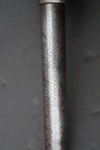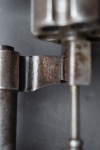
|
Colt US Army Model 1892 DA Revolver |
This is an early 1st Contract Colt US Army Model 1892 Double Action Revolver. These were use in the last days of the western frontier by the US Cavalry, saw action in the Spanish-American War, and then the Philippines where it was found to lack stopping power against the Moros. They were also used by the US Navy and reserve units in World War I and a few all the way up until World War II. In some ways, it is responsible for the development of the .45 Colt Model 1911. This one was never redone, rebuilt, or remarked by Colt, nor does it have the 1901 upgrades like most 1892's. There were a total of 8,000 US Model 1892's shipped to the US Army. This one is in the 1,300 serial range. It has the standard 6" barrel in caliber .38 Colt with the military walnut grips instead of checkered hard rubber as found on civilian models. Barrel has the early 1884 and 1888 patent dates. RAC (Ronaldo A. Carr) inspector stamps/cartouches can be found on the bottom of the barrel, rear face of the cylinder, frame, and grips. Since this was the first official main issue revolver in double action to the US Army, some problems were bound to arise with the Model 1892. The Army had cautiously stood back and let the US Navy order the Model 1889 double action to see how the revolver fared in service conditions and noted the improvements made; mainly the addition of a secure bolt lock/notches for the cylinder. That said, while the 1892 was a vast improvement over the original 1889 design, the Army did find a problem about a year after the 1892 was adopted. If the cylinder latch was not fully engaged, the gun could still be fired. The Army made Colt aware of the problem and Colt quickly came up with a solution in the form of a safety device that blocks the hammer when the cylinder latch is not fully engaged. Colt took out a patent on the fix and all subsequent orders had the hammer blocking device which became known as the Model 1894. Colt was expecting the Army to return all of the 1892's for the upgrade but the Army had other plans. Instead, they began ordering the hammer block components and having their own arsenal at Springfield carry out the modifications. The cost of the spare parts were pennies on the dollar for what Colt would have charged. However, from Colt's point of view, they had come up with the solution to the problem, patented it, had made an investment on the improvement, and they felt the Army shouldn't get the fruits of their labor for next to nothing so what did they do? Apparently, they refused to sell the Army any more spare parts for upgrading the Model 1892. This forced the Army to send the bulk of their 1892's back to Colt which not only got the hammer blocking device, but were rebuilt, remarked with the Model 1894 designation, and were refinished back to new. This was the fate of most of the 1892's...they were redone by Colt while some were simply upgraded by Springfield with just the device. There were also a small few that were never upgraded...about 300 out of 8,000 which likely went to National Guard units or were lost or stolen. This particular example is one of the ones that received the upgrade by Springfield and thus, still wears its original Model 1892 markings and early patent dates. From there, it never had the 1901 upgrade where Colt rebuilt these revolvers again and installed a lanyard loop. It also escaped the rebuild program in World War I where thousands of Colt US Army DA's were refinished at Remington. It just has the first upgrade and because it was done by Springfield and not Colt, it is as close to its original form as you'll find excluding the few that escaped all the upgrades....only about twenty known and they are EXPENSIVE! Overall Condition grades to NRA Antique Good with the metal having turned to a gray patina that is mostly smooth with some salt and pepper specks of corrosion. When we acquired this revolver, it had been in storage for decades and had come out of a shed. The edges and markings are all present and good. The grips are surprisingly good for 125 years old with both of the early cartouches visible. Action works in both double and single action modes. The bore is average. The rifling is there and strong enough to spin a cleaning rod attached to a wire brush but there are some pits...typical for a service revolver from the late 19th century. Good solid example of an early Colt Model 1892 issued to the US Army. Item# 1959 SOLD |
 |
 |
 |
 |
 |
 |
 |
 |
 |
 |
 |
 |
 |
 |
 |
 |
 |
 |
 |